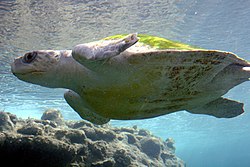Nichollsemys
| Nichollsemys | |
|---|---|

| |
| Skull, Royal Tyrrell Museum in Alberta, Canada | |
| Scientific classification | |
| Domain: | Eukaryota |
| Kingdom: | Animalia |
| Phylum: | Chordata |
| Class: | Reptilia |
| Order: | Testudines |
| Suborder: | Cryptodira |
| Superfamily: | Chelonioidea |
| Genus: | †Nichollsemys Brinkman, 2006[1] |
| Species | |
| |
Nichollsemys is a genus of extinct sea turtles. The only known species is Nichollsemys baieri.[2]
Fossils
Fossils of the Nichollsemys have been found in Alberta, Canada, by Donald Brinkman.[3] The fossils found are all skulls.
Description
The full length of the Nichollsemys is unknown, but Brinkman made a chart of the length of some parts of the specimen. The length from the basioccipital to the premaxilla measures 11.4 cm, the width of all the quadrates measures 9.8 cm, the depth at level of the quadrates measures 7.1 cm, the intraorbital width measures 2 cm, and the length measures 3.6 cm. [4] The cranium has many things in common with that of Toxochelys: for example, they both have a rostrum basisphenoidale shaped like a rod.
Name origin
The name of Nichollsemys is a tribute to Elizabeth Nicholls, a paleontologist from Canada who studied marine reptiles from the Triassic period. She had previously done work with Brinkman when they found the ichthyosaur genus Pattinatator.[5]
References
- ^ Brinkman, D. (2006), A primitive chelonioid turtle from the late Campanian of North America
- ^ Global Biodiversity Information Facility, 2019: Nichollsemys (Brinkman, Hart, Jamniczky & Colbert, 2006)
- ^ Fossilworks, 2013: Nichollsemys (Behrensmeyer, A. K., and Turner, A.)
- ^ Brinkman, Donald B, et al.: "Measurements of the Skull of Nichollsemys Baieri." Research Gate, Sept. 2006
- ^ Paleofile: Nichollsemys. Accessed 16 June 2020

